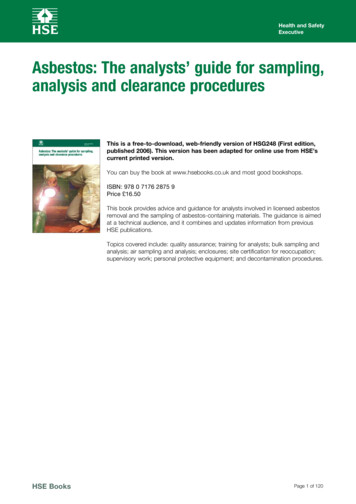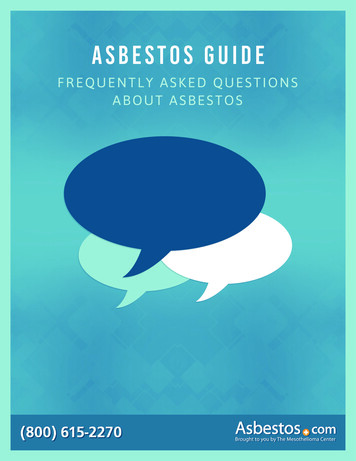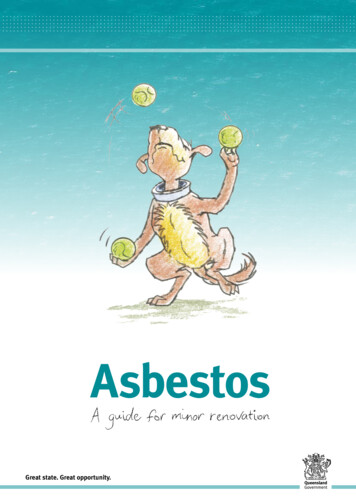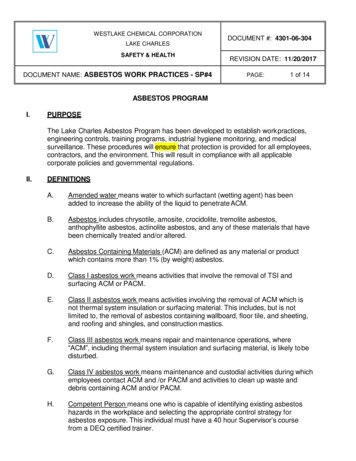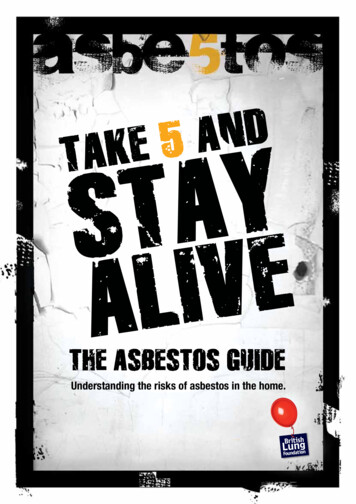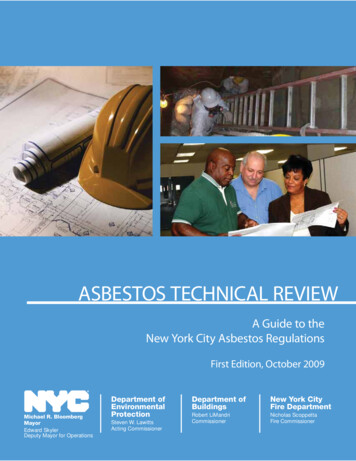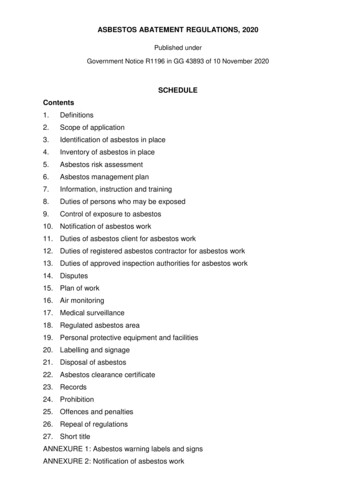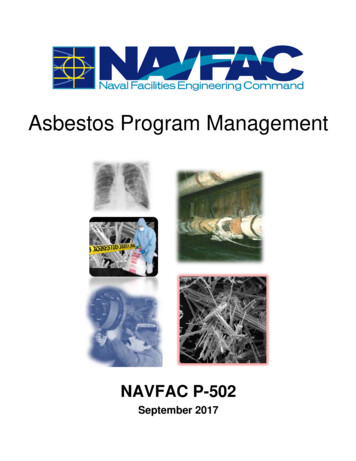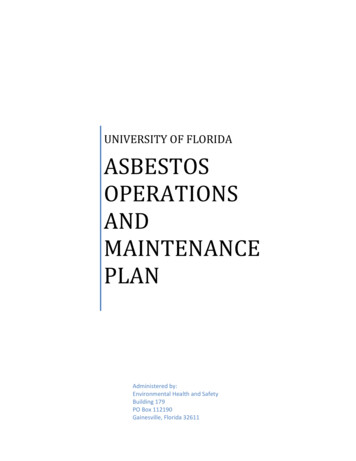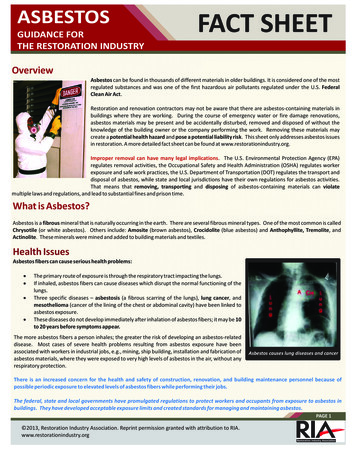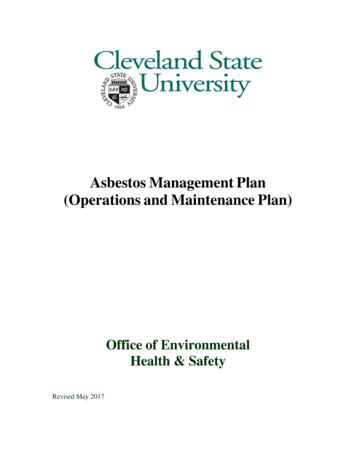
Transcription
Asbestos Management Plan(Operations and Maintenance Plan)Office of EnvironmentalHealth & SafetyRevised May 2017
Table of ContentsIntroductionScopeI.Program AdministrationA. Environmental Health and SafetyII.Permissible Exposure LimitIII.Location of Asbestos-Containing Material on CampusIV.Classification of Asbestos WorkV.Class I, II, and III Asbestos WorkA. Environmental Operations (Facilities Management)B. Building Maintenance (Facilities Management)C. Utilities (Facilities Management)D. Outside Management FirmsE. Outside ContractorsVIClass IV Asbestos WorkA.B.C.D.E.F.G.VI.Building Maintenance (Facilities Management)Building Services (Facilities Management)Capital Planning & Development (University Architect)Fire Prevention & SecurityInformation Services & Technology (IS&T)University PoliceUtilities (Facilities Management)Building Inspection and Surveillance of Asbestos Containing Material onCampusA. Existing BuildingsB. New ConstructionVIII. Work PracticesIX.Disposal of Asbestos Containing MaterialX.Employee Notification
XI.LabelingXII.Medical SurveillanceXIII. Respiratory ProtectionXIV. TrainingXV.Contractor AwarenessXVI. Emergency Response ProceduresXVII. RecordkeepingXVIII. Air MonitoringAppendix A – CSU Campus List of Buildings Surveyed for ACMAppendix B – Acknowledgement of Receipt of Asbestos DocumentsAppendix C - Recommended Work Practices for Removal of Resilient FloorCovering
IntroductionThe Cleveland State University Asbestos Management Program has been developed tocomply with the requirements of the Occupational Safety and Health Administration(OSHA) Asbestos Standards for General Industry (29 CFR 1910.1001) and Construction(29 CFR 1926.1101), the Environmental Protection Agency (EPA). AsbestosNESHAP 40 CFR (41 Parts 61 and A H E R A 4 0 C F R P a r t 7 6 3 Sub part E , andthe Ohio Department of Health (ODH) found in the Ohio Administrative Code’s (OAC)Final Rule 3701-34.Cleveland State University is committed to the health and safety of the entire campuscommunity (employees, students and visitors). The presence of asbestos-containingmaterial (ACM) in some University Buildings has been established through survey andinspection procedures. The objectives of this asbestos management program include, butare not limited to, the inspection and identification of asbestos-containing materials(ACM), hazard communication, training, maintenance and repair or removal of ACM inUniversity-owned facilities. This program is intended protect employees, students andvisitors from potential health hazards associated with asbestos, and to ensure ACM willbe handled in compliance with all applicable federal, state and local regulations.ScopeThe Cleveland State University Asbestos Management Program is administered by theOffice of Environmental Health & Safety (OEHS). The Departmental Director, in thecapacity of EHS Compliance Officer, serves as the University Asbestos Coordinator.Program requirements apply to all University-owned buildings and employees (includingcontracted employees) performing maintenance, repair and housekeeping services. Inaddition, all capital planning, construction, renovation and demolition projects are subjectto the provisions of this program. Facilities Management Staff and Project Managersshall contact the Office of Environmental Health & Safety (OEHS) early in the planningstages of a project to reduce the potential for regulatory liability and to ensure an adequatesource of funding in the project budget to address asbestos issues. EHS shall be consultedand/or notified prior to physically disturbing any building material, structure or otherpotentially ACM.I.Program AdministrationThe OEHS shall be responsible for administration of the University AsbestosManagement Program. Various departments across campus may be affected by theprovisions of this program, including but not limited to:Facilities Management (Building Maintenance, Building Services, EnvironmentalOperations, Utilities), Capital Planning and Development (University Architects),Fire Prevention and Security, Informational Service and Technology (IS&T) andUniversity Police Department.
A. Environmental Health & Safety – Asbestos ManagementThe OEHS is responsible for the development, implementation and administrationof the University Asbestos Management Program, including but not limited to: Asbestos Management Program development, direction andimplementationDeveloping, implementing, and conducting and/or facilitatingappropriate asbestos training programsCoordinating response to all emergencies on campus involving ACMConducting and/or supervising all asbestos building surveys andinspectionsReviewing all asbestos abatement projects for complianceManagement and Oversight of activities performed by asbestosconsultantsMaintaining all records and documentation pertaining to asbestoscomplianceRobert Howerton, B.S., AHES, CHMM Interim Director of Environmental Health& Safety and EHS Compliance and Radiation Safety Officer. Robert maintainscertification in the State of Ohio as an Asbestos Hazard Evaluation Specialist(AHES)Asbestos Coordinator for the asbestos program management is Mike Samec, B.A.,AHAS, AHES, Environmental Health and Safety Officer. Mike maintainscertification in the State of Ohio as an Asbestos Hazard Abatement Specialist(AHAS) and Asbestos Hazard Evaluation Specialist (AHES).Dave Diggins, B.S., AHES, Environmental Health and Safety Officer. Davemaintains certification in the State of Ohio as an Asbestos Hazard EvaluationSpecialist (AHES).II.Permissible Exposure Limit (PEL)OSHA has established the permissible exposure limit (PEL) for airborne concentration ofasbestos above which no employee may be exposed at 0.1 fibers per cubic centimeter(f/cc) as an eight (8) hour time-weighted average.In addition, a short-term exposure limit (STEL) for asbestos as averaged over a samplingperiod of thirty (30) minutes at 1.0 f/cc.
III. Location of Asbestos-Containing Material on CampusThe University has conducted multiple surveys and inspections of its buildings for ACM.Evidence has been documented that the following University Buildings contain ACM:Administration CenterAdvanced Manufacturing AnnexBaker’s UnionCAMP BuildingCole Center/Campus InternationalCollege of BusinessEast Parking GarageFenn TowerField Locker BuildingField Services BuildingHealth SciencesHowe MansionLaw BuildingLaw LibraryMain ClassroomMather MansionMiddough BuildingMusic & CommunicationParker Hannifin HallPhysical EducationPlant AnnexPlant ServicesRhodes TowerScience BuildingScience Research BuildingStilwell Hall (Fenn Hall)Student CenterTheater ArtsUnion BuildingUniversity Parking FacilityUrban AffairsWallingford Coffee BuildingWest Parking GarageWolstein Center
IV.Classification of Asbestos WorkThe Occupational Safety and Health Administration (OSHA) classifies work involvingACM by the class and type of material:Class 1 Asbestos Work – activities involving the removal of thermal systeminsulation (TSI) and surfacing asbestos containing material (ACM) and presumedasbestos containing material (PACM)Class II Asbestos Work – activities involving the removal of ACM which is notthermal system insulation or surfacing material. This includes, but is not limitedto, the removal of asbestos containing wallboard, floor tile and sheeting, roofingand siding shingles, and construction masticsClass III Asbestos Work – Any repair and maintenance operations where ACM, islikely to be disturbed up to 1 glove bag or disposal bag.Class IV Asbestos Work – maintenance and custodial activities during whichemployees contact but do not disturb ACM and PACM.V.Class I, II, and III Asbestos WorkA. Environmental Operations (Facilities Management)Environmental Operations (Facilities Management) conducts maintenance inareas known to contain ACM, repairs ACM that may become damaged duringmaintenance, and performs minor abatement (i.e., typically involving less thanone bag of materials). Designated individuals assigned to these tasks possesscertification, hold state licensure and receive training applicable to the specificasbestos-related tasks performed and are permitted to do asbestos work consistentwith this training. Team members are provided medical exams, personalprotective equipment (PPE), training and licensing on an annual basis, andparticipate in the University Respiratory Protection Program. Designatedmembers:*Perform maintenance and repair of all material known to contain ACM*Obtain and maintain equipment and supplies necessary for asbestosrelated projects*Respond to emergencies involving ACM and potential fiber releases
*May abate ACM if amounts are determined to be less than 50 linear, orsquare feet per ODIT. Abatement activities referenced are to beconsidered those that involve routine maintenance activities. Asbestosabatement related to renovations and capital improvement projects maybe performed based on staff availability, with the cost of such abatementto be assessed to the project budget*May supervise the maintenance, repair and abatement of ACM if work isperformed by a licensed outside contractor*May provide consultation and recommendations for campus asbestosprojects within scope of training*Coordinate removal and disposal of all asbestos-containing material withThe OEHS.Environmental Operations (Facilities Management) reserves the right to assesscharges to departments and/or projects for any asbestos abatement or cleanupcosts associated with their failure to adhere to the policies and provisions of theUniversity Asbestos Management Program.Environmental Operations (Facilities Management) personnel involved in theAsbestos Management Program possesses training as Class I Workers (except theDirector):Shehadeh Abdelkarim Director of Facilities ManagementMark Cunningham Asst. Director of Facilities ManagementB. Building Maintenance (Facilities Management)Building Maintenance may opt to address work with asbestos containing materialfor which they are responsible, including repairs and maintenance by contractingthe work out to a licensed asbestos abatement firm whose employees possess theappropriate training and certification under EPA, ODH and OSHA.No university employee assigned to this Department shall disturb any asbestoscontaining building material as part of their duties unless they have been directedto and have had the training appropriate to the type of material involved.
C. Utilities (Facilities Management)Utilities may opt to address work with asbestos containing material for whichthey are responsible, including repairs and maintenance by contracting the workout to a licensed asbestos abatement firm whose employees possess theappropriate training and certification under OSHA.No university employee assigned to this Department shall disturb any asbestoscontaining building material as part of their duties.D. Outside Management FirmsCertain Buildings are managed by outside firms under contract with CSU.Currently the buildings and respective management firms are:University Bookstore .Nebraska Book CompanyFenn Tower American Campus CommunityStudent Center .ChartwellEuclid Commons . .American Campus CommunityE. Outside ContractorsMany University departments may facilitate work that is performed by outsidecontracted employees. All University departments, including those identified inthis management plan are responsible for notifying all outside contractedemployees in writing of the presence and location of asbestos containing materialsin their respective buildings. University representatives shall facilitate the outsidecontractor’s signature on an Acknowledgement of Receipt Form (Appendix B)when providing asbestos documents to outside contracted companies. Thesedepartments may obtain information about asbestos in their buildings bycontacting the Office of Environmental Health and Safety.
VI.Class IV Asbestos WorkDepartments which designate employees not require to handle, but may workaround, contact, and subsequently be impacted by the presence of ACM (definedas Class IV Work by OSHA). Employees of these departments receive two (2)hour Asbestos Awareness Training on an annual basis.Should any activities managed by these departments be assigned to outsidecontractors, and the proposed project involves work in areas known to have ACM,departmental personnel are responsible for providing information to thesecontractors regarding the presence of ACM, and for notifying the OEHS prior toany work being performed.These departments include, but are not limited to:A. Building Maintenance (Facilities Management)Building Maintenance (Facilities Management) has responsibility for theinstallation, operation and maintenance of plumbing systems, lighting andfixtures, glass replacement, signage, painting and keys. Such duties canresult in employees entering and performing work in areas known to haveACM.B. Building Services (Facilities Management)Housekeeping, janitorial and moving activities are provided by BuildingServices (Facilities Management) on a daily basis. Employees clean allareas of campus, polish and wax floors, remove trash and move equipmentacross campus. Employee activities may involve cleaning areas known tohave ACM but are unlikely to involve contact this material directly withthe exception of resilient floor covering.C. Office of the University ArchitectThe Architects and related staff that facilitate and manage buildingconstruction and renovation projects on campus. Personnel serve asProject Managers and may frequently perform site visits to oversee andensure work progress.
D. Fire Prevention (Access Control & Security Systems)Fire Prevention & Security, under Access Control, maintains fire systems,repair and inspection of alarms and equipment, including but not limited tosprinklers, fire extinguishers and other suppression equipment, fire alarms,and security surveillance and alarm systems. Such building systems maybe located in areas that contain ACM.E. Information Services & Technology (IS&T)The Department of Information Services and Technology (IS&T) isresponsible for ensuring the availability of technology resource systems(computers, telephones, wireless campus, etc ) to the campus includinginstallation, maintenance and repair, and security for those systems. Aspart of these activities, employees may be required to work in areas whereACM are present.F. University PoliceThe University Police Department is charged with the responsibility forproviding a safe and secure environment for the entire campuscommunity. Their routine patrol of, and emergency response to, campusbuildings covering over 5.3 million square feet may result in officers beingrequired to be present in areas where ACM is or may be present.G. Utilities (Facilities Management)The Utilities Department (Facilities Management) maintains anddistributes energy services to campus buildings including, but not limitedto steam, electricity, domestic water, gas, and storm water and sanitarywaste removal. Utility distribution systems may be located in areas thatcontain ACM.VII. Building Inspection and Surveillance of Asbestos Containing Material onCampusA. Existing BuildingsSurveys identifying the location of ACM in existing campus facilities have beenperformed. Survey reports (one for each campus building) include lists ofhomogenous materials, lab reports, assessment of condition and hazard potentialof each ACM, and approximate square or linear footage. Written reports alsoinclude photographs and a floor plan of every building that illustrates the locationof ACM.
Copies of building inspection reports have been provided to the following campusdepartments:Office of Environmental Health and SafetyFacilities Management (Environmental Operations)Facilities Management (Building Maintenance)O f f i c e o f t h e University ArchitectFacilities AdministrationU n i v e rs i t y PoliceFacilities Management (Utilities)In addition, copies of asbestos building inspections have been provided to outsidecontracted management firms for the buildings they are assigned to manage:Student CenterIdentified Areas of:Business CollegeLaw BuildingRhodes TowerStilwell Hall (Fenn Hall)IMPORTANT: University representatives shall facilitate the outside contractor’ssignature on an Acknowledgement of Receipt Form (Appendix B) whenproviding asbestos documents to outside contracted companies.Campus buildings shall be subject to re-inspection every three years by anaccredited building inspector.B. New ConstructionIt is recommended that new construction/remodeling projects include costs forsampling of building material to be used in the project prior to installation,eliminating the need for a construction survey prior to renovation.VIII.Work PracticesWork Practices are established as being performed by two major groups: CSU EmployeesContracted Employees
CSU EmployeesBuilding construction and/or renovation activities physically performed by CSUEmployees require the following actions prior to beginning any construction and/orrenovation activities:1. Upon receipt of a Service Request and/or Work Order, responsible departmentshall review the Building Inspection Report for that building room/area toverify the presence or absence of ACM. This is done by theForeman/Supervisor/Project Manager.2. If the building area/room is indicated as not having any ACM, work may thenproceed.3. If the building area/room is slated for abatement of ACM (Class I and IIWork), the employees shall:a. Provide notification to the Ohio Department of Health (ODH) andCleveland Division of Air Quality (CDAQ) at least ten (10) workingdays prior to performing the work where applicable.b. Follow procedures as set forth by OSHA for Class I and II Workincluding but not limited to use of wet methods, flame resistantpolyethylene film six (6.0) mil in thickness, glove bagging, erectingcritical barriers, modification/isolation of building ventilation systemto that area, air filtration devices (AFDs), providing for a minimum offour (4) air exchanges per hour, maintaining a negative pressuredifferential of at least or in excess of 0.02 inches of waterc. Notify the Office of Environmental Health and Safety 48 hours priorto the start of the project.d. Establish a regulated area where airborne asbestos is likely to exceedthe PEL and post warning signs bearing the following information:DANGERASBESTOSMAY CAUSE CANCERCAUSES DAMAGE TO LUNGSThe following information must be added when PPEis required.WEAR RESPIRATORY AND PROTECTIVECLOTHING IN THIS AREAe. Wear appropriate disposable personal protective clothing that mayinclude coveralls or similar whole-body clothing, head coverings orhood, gloves and foot coverings, and adhere to decontaminationprocedures set forth by OSHA.
f. Wear respiratory protection, in conjunction with the University’sRespiratory Protection Program, unless a negative exposureassessment has been performed or air monitoring has demonstrated thepermissible exposure limit for asbestos has not been exceeded.g. Perform daily air monitoring for employees working in a regulatedareah. Facilitate clearance monitoring before returning the room/area to usei. Report any other damaged ACM in the area immediately to theOEHS.4. If the building area/room is indicated as having ACM, and the work activityand/or repair involves disturbing existing ACM (Class III Work), then theemployees shall:a. Follow procedures set forth by OSHA for Class III Work whichincludes but is not limited to wet methods and local exhaustventilation, when appropriate. If the possibility of exposure exists,isolate the area from the building HVAC systemb. Wear appropriate disposable personal protective clothing that mayinclude coveralls or similar whole-body clothing, head coverings orhood, gloves and foot coverings, and adhere to decontaminationprocedures set forth by OSHA.c. Where drilling, cutting abrading, sanding, chipping, breaking orsawing thermal system insulation takes place, employees shall employthe use of impermeable drop cloths, glove bag systems, smallenclosures or other effective means of isolation and techniques thatwill capture fibers.d. Wear respiratory protection, in conjunction with the University’sRespiratory Protection Program, unless a negative exposureassessment has been performed or air monitoring has demonstrated thepermissible exposure limit for asbestos has not been exceeded.e. Report any other ACM that is observed to be damaged in the areaimmediately to The OEHS.5. If the building area/room is indicated as having ACM and the work activityinvolves custodial activities (housekeeping, etc ), then employees shall:a. Exercise care when cleaning, buffing stripping, floor tiles that areknown to have ACMb. Never sand or physically abrade ACM Floor Tile.c. Use wet methods and low abrasions pads at speeds less than threehundred (300) revolutions per minute (RPMs).d. Report any additional ACM material that is observed to be damagedimmediately to The OEHS6. Floor tile shall be addressed in conjunction with the recommended proceduresof the Resilient Floor Covering Institute (RCFI) – see Appendix C. Report anyadditional ACM material that is observed to be damaged immediately to theOEHS.
Contracted EmployeesContractors performing work in areas where asbestos-containing materials are presentshall comply with all federal, state and local legislation pertaining to safely andcompliantly working with asbestos containing material, including but not limited to theprocedures set forth above. See CSU”s Contractor Awareness Guide requirements forasbestos.IX.Disposal of Asbestos Containing WasteAll asbestos-containing waste material is to be wetted and placed in polyethylene bags(double-bagged) at least six (6.0) mil in thickness bearing the followinginformation/labels:First Label: In accordance with 29 CFR 1910.1200 (f) of OSHA’s HazardCommunication Standard:MAY CAUSE CANCERCAUSES DAMGE TOLUNGS DO NOT BREATHDUST AVOID CREATINGDUSTSecond Label: Provide in accordance with the U.S. Department of Transportationregulation on hazardous waste marking, 49 CFR parts 171 and 172, HazardousSubstances: Final Rule. Published November 21, 1986 and revised February17,1987:RQ (ASBESTOS)CLASS 9NA 2212P.G.IIIUniversity employees trained to work with and disturb asbestos containing material aspart of their duties shall contact the OEHS to manage the removal. All asbestos wastematerial shall be stored in secured area and disposed of using licensed transporters anddisposal facilities.Outside contracted employees shall be responsible for appropriate and compliant removalof asbestos containing material off campus. Waste manifests shall be provided to thecontracting University department and copies to the Office of Environmental Health andSafety.
X.Employee NotificationEmployees will be notified whenever applicable and prior to any work with asbestoscontaining material in their immediate or adjacent area.XI.LabelingSignage identifying the presence and location of asbestos containing materials shall beposted at the entrance to mechanical rooms or areas that contain thermal systeminsulation and surface asbestos-containing materials. Specific work practices to ensurethe material is not disturbed shall also be present.XII.Medical SurveillanceDesignated individuals who possess certifications to perform Class I, II and III AsbestosWork are required to participate in the Medical Surveillance Program. Prior toperforming asbestos work, individuals undergo a medical examination. Medicalevaluations are performed by:St. Vincent Charity HospitalOccupational Medicine Center2475 East 22nd Street, Suite 310Cleveland, Ohio 44115XIII. Respiratory ProtectionDesignated individuals who are required to wear respiratory protection are enrolled in theUniversity’s Respiratory Protection Program. Initially before assignment, and annuallythereafter, workers undergo a qualitative fit test. Annual exams are performed todetermine whether asbestos work has caused harmful effects. All fit testing is performedby:St. Vincent Charity HospitalOccupational Medicine Center2475 East 22nd Street, Suite 310Cleveland, Ohio 44115XIV. TrainingEmployees are provided required training based on the particular class of workthey may perform:Class I and II Asbestos Work – employees complete a 32-hour course addressingthe performance of asbestos abatement activities. Course content includesbackground information pertaining to asbestos, health effects, personal protectiveequipment, respiratory protection, safe work practices, and regulatoryrequirements.
Hands-on training includes the use of protective equipment, asbestos removaltechniques and preparation of an area for abatement work. Class I and IIAsbestos Workers are also qualified to perform Class III and IV asbestosactivities.Some employees are provided specialized training on removal of Class IIflooring. These employees may remove and replace cracked/damaged floor tilethat is non-friable only. Any floor tile that has become friable will be handled byother Class I and II Asbestos Workers.Class III Asbestos Work (Operations and Maintenance) – employees complete a16-hour course addressing asbestos activities. These employees may be involvedin work that may disturb asbestos containing materials for the purpose ofaccessing building components and equipment. Course content includesbackground information pertaining to asbestos, health effects, legal issues,respiratory protection, work practices, supervisory skills, and regulatoryrequirements. Hands-on training includes the use of protective equipment,asbestos removal techniques, and preparation of small work areas for abatement.Class III Asbestos Workers may act as competent persons for Class III and IVasbestos activities.Class IV Asbestos Work – employees complete a 2-hour awareness course whichincludes general information on the types of asbestos, labeling, identifyinghazardous areas associated health effects, and how to reduce the risk of exposureusing safe work practices.XV.Contractor AwarenessContractors employed by the University shall be informed in writing by theProject Manager (PM) for the project/repair of the location of suspect and knownACM in the area they are to perform work. Project Manager shall facilitate theoutside contractors signature on an Acknowledgement of Receipt Form(Appendix B) when providing asbestos documents to outside contractedcompanies. Contractors shall not disturb any suspect or known ACM unless theiremployees have received the appropriate training specified for the work, and ifapplicable hold the appropriate state license.XVI.Emergency Response ProceduresThere is a small chance that any campus building containing ACM is potentiallysubject to a fiber release episode. Employees are to adhere to the followingprotocol when reporting a potential fiber release in an area known to containACM:1. Leave and secure the area in such a manner that prevents entry byunauthorized personnel.2. Notify the immediate supervisor of the incident.
3. If in the area of fiber release, seek medical attention (be sure to fill outan accident/incident report)4. Contact the OEHS via the CSU Public Safety Answering Point (PSAP)– Campus Safety Dispatch by dialing x 2020 from any campus phone.Cell phone users may also dial 9-1-1 and ask operator to beconnected with CSU Police. The CSU Dispatcher will in turn contactthe OEHS.5. The Asbestos Coordinator will ensure area(s) have been properlysecured, and facilitate a response by an external abatement contractor,or assign a trained in-house team to make repairs and clean up anydebris in a timely fashion.6. A post-incident review will be held to evaluate the response withapplicable University Departments.XVII.RecordkeepingAll documentation records pertaining to elements identified in this AsbestosManagement Plan (Operations and Maintenance Plan) are maintained by theOEHS that include, but are not limited to: Written Operations and Maintenance Plan Survey data, including building plans and drawings Notifications and labels Training Programs Written Respiratory Protection Program Any permits and information pertaining to maintenance andrenovations performed, including emergency response Abatement Records
XVIII. Air Monitoring1. All air samples measuring for asbestos will use Transmission Electron Microscopymethod for the following procedures. Background Environmental Final Air Clearance Surveillance2. Volumea. Minimum of 560 Liters will require to be collected for Background,Environmental, and Surveillance monitoring purpose. (It is recommend tocollect 1200 – 1800 Liters)b. Minimum of 1200 Liters will require for Final Air Clearance.3. Air monitoring results will be read from a 3rd party lab.a. If results of the readings are listed as “Incomplete” or “Overloaded.”Overloaded filters are deemed as “VOID”.4. Aggressive air sampling will be required after the completion and passing of thefinal visual inspection.
Appendix ACSU Campus List of Buildings Surveyed for ACMCSU BuildingAdvancedManufacturing CenterAMC AnnexAM ExtensionArt BuildingCampus PoliceDepartmentChester BuildingCampus InternationalCollege of BusinessCollege of UrbanAffairsConvocation CenterCorlett BuildingDoan ElectricFenn TowerField Locker BuildingField ServicesBuildingHealth SciencesParker HannifinAddressACM Present1751 East 23rdDemoSupervisor To ReviewService Request/WorkOrderYes1751 East 23rdEast 25th2301 Chester1870 East 19thYesYesDemoYesYesYesYesYes2300 Chester3100 Chester1860 East 18th Street1717 EuclidYesYesNONOYesYesNONO2000 Prospect1935 Euclid1807 East 22nd1983 East 24thNODemoDemoNO;ABATEDWINTER 2004YesNONOYesYesYesNONO1842 Payne1848 Payne2501 Euclid2258 EuclidYesNOIntramural SportsCenterKinko’sLaw BuildingLaw LibraryMain ClassroomMusic &CommunicationPhysical EducationPlant ServicesPlant Annex1881 East 24thNONO; ABATEDSPRING 2004Demo2112 Euclid1801 Euc
III. Location of Asbestos-Containing Material on Campus. IV. Classification of Asbestos Work. V. Class I, II, and III Asbestos Work. A. Environmental Operations (Facilities Management) B. Building Maintenance (Facilities Management) C. Utilities (Facilities Management) D. Outside Management Firms E. Outside Contractors VI Class IV Asbestos Work
